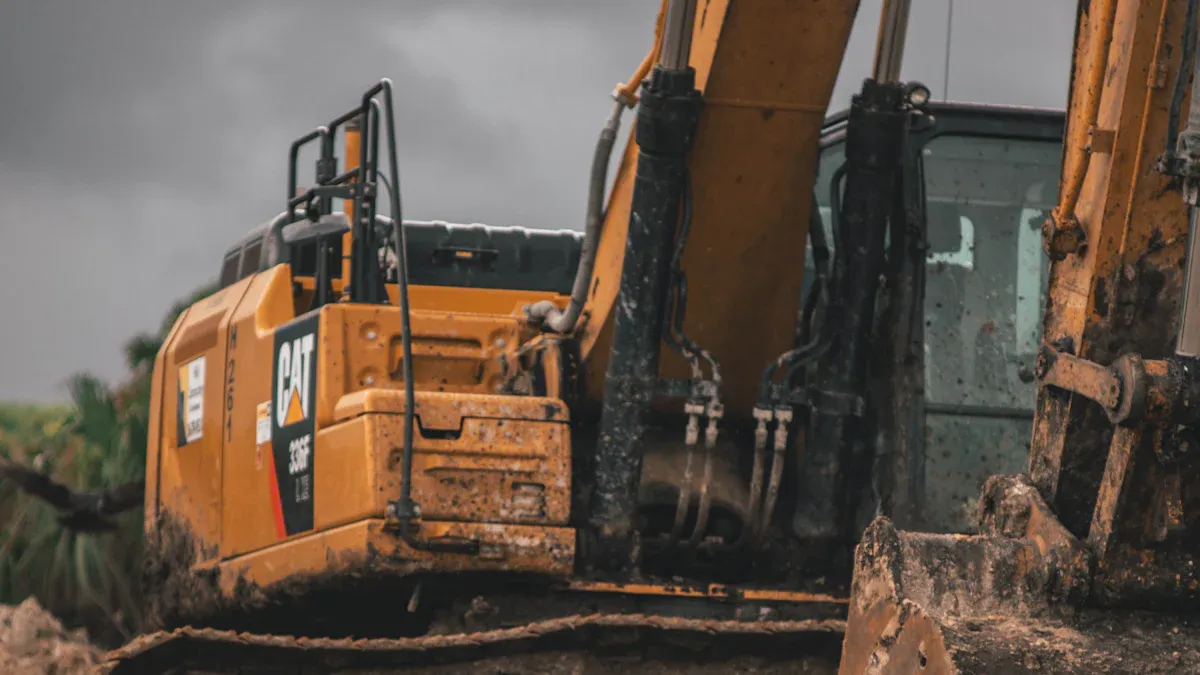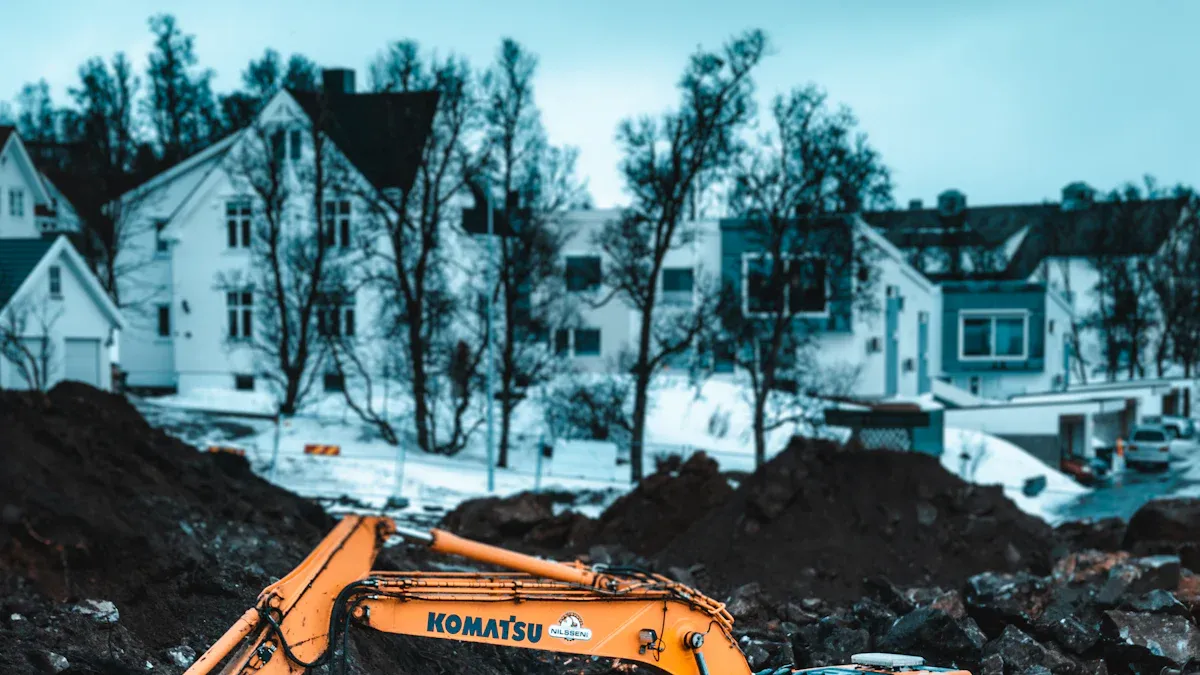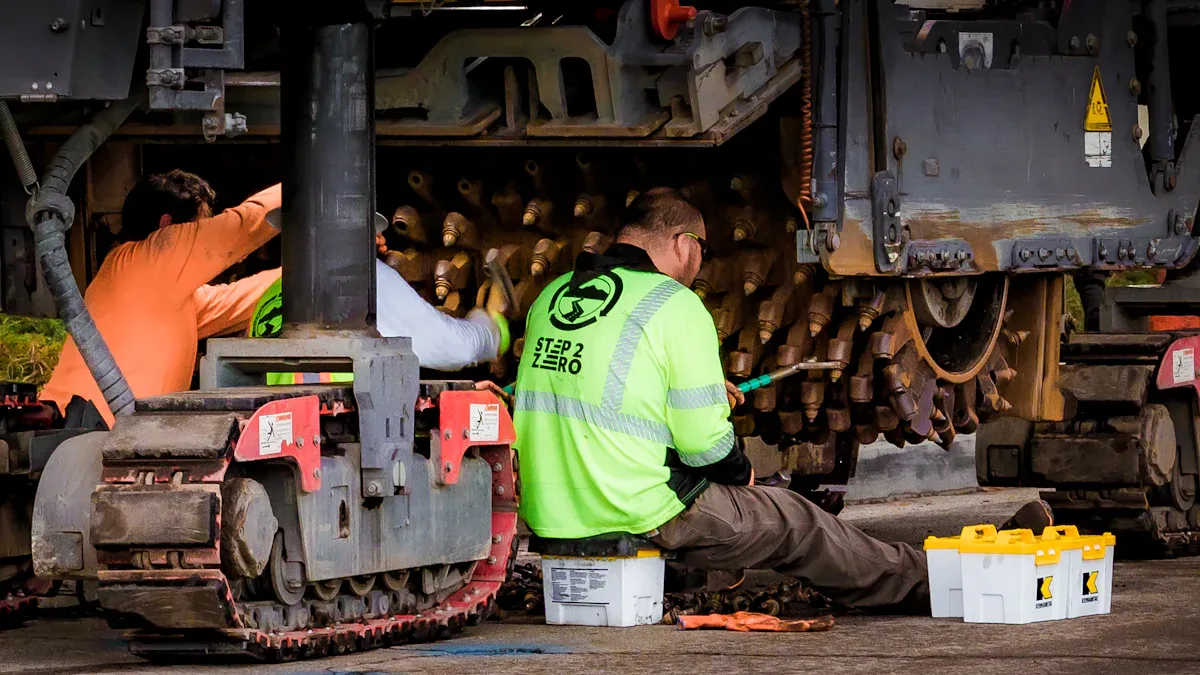
Ground engaging tools are essential components of heavy machinery, directly interacting with the ground during operations. These tools, which often utilize a pin and retainer system for secure attachment, play a pivotal role in construction and mining. Research highlights that advancements in their design, including the use of a hex bolt and nut for enhanced stability, improve performance and cut costs. The market’s projected growth to USD 9.2 billion by 2032 underscores their growing demand for durability and efficiency.
Key Takeaways
- Checking ground engaging tools often stops sudden breakdowns and big costs. Make a habit of checking them to keep them working well.
- Changing old tools on time helps work faster and saves fuel. Watch for signs of wear to know when to replace them.
- Buying good-quality tools saves money over time. Pick reliable brands to make sure they last and fit your machines.
Types of Ground Engaging Tools

Ground engaging tools come in various types, each designed to perform specific tasks in construction, mining, and other heavy-duty applications. These tools enhance the efficiency and durability of machinery by interacting directly with the ground. Below are the primary types of ground engaging tools:
Cutting Edges
Cutting edges are vital for equipment like bulldozers, graders, and loaders. These components improve the cutting performance of blades and protect the base edge of buckets. Made from materials such as alloy steel or cast iron, cutting edges are ideal for excavation, grading, and trenching tasks. Their durability ensures prolonged use in harsh environments.
Bucket Teeth
Bucket teeth are essential for excavators and loaders. These tools penetrate tough surfaces like rock and compacted soil. They come in various shapes and materials, including steel and ceramic, to suit different applications. Regular inspection and replacement of bucket teeth prevent wear and maintain operational efficiency.
Ripper Shanks
Ripper shanks are designed for breaking up hard ground or rocky surfaces. These tools are commonly used in mining and road construction. Their robust construction, often from high-strength steel, ensures they withstand extreme stress during operations.
Blades and End Bits
Blades and end bits are critical for dozers and graders. They provide precision in leveling and grading tasks. End bits, positioned at the blade’s edges, protect against wear and extend the blade’s lifespan. These tools are indispensable for road construction and maintenance.
Specialized Ground Engaging Tools
Specialized tools cater to unique applications, such as side cutters for bucket reinforcement or polyurethane components for reduced wear in specific environments. These tools address niche requirements, ensuring machinery operates efficiently in diverse conditions.
Note: The table below highlights the variety of ground engaging tools based on product type, material, application, and end-use:
| Category | Types/Materials/Applications/End-uses |
|---|---|
| By Product Type | Bucket Teeth, Adapters, Cutting Edges, Blades, Others |
| By Material | Steel, Alloy Steel, Cast Iron, Polyurethane, Ceramic |
| By Application | Excavation, Loading, Grading, Trenching, Mining, Others |
| By End-use | Construction, Mining, Agriculture, Others |
Ground engaging tools play a crucial role in excavation, loading, and grading operations. Their demand continues to rise due to urban development, road construction, and mining activities.
Importance of Maintaining and Replacing Ground Engaging Tools
Preventing Downtime and Equipment Damage
Maintaining ground engaging tools is essential to avoid unplanned downtime and prevent equipment damage. A preventive maintenance plan ensures that tools remain in optimal condition, reducing the likelihood of sudden failures. Regular inspections focusing on critical areas, such as base edge cracks or excessive wear on bucket tips, help identify potential issues early. This proactive approach minimizes disruptions to operations and extends the lifespan of heavy machinery.
Tip: Establishing a routine inspection schedule can significantly reduce the risk of costly repairs and operational delays.
| Key Maintenance Practice | Benefit |
|---|---|
| Regular inspections | Prevents unplanned maintenance and equipment damage |
| Timely replacements | Enhances productivity and safety |
| Use of high-quality G.E.T | Reduces maintenance costs and downtime |
Improving Efficiency and Productivity
Well-maintained ground engaging tools directly contribute to improved efficiency and productivity. Tools in good condition perform tasks more effectively, reducing the time and effort required for excavation, grading, or mining operations. For example, sharp bucket teeth penetrate tough surfaces more easily, decreasing operator fatigue and fuel consumption. Additionally, timely replacement of worn-out tools ensures that machinery operates at peak performance, enabling projects to stay on schedule.
Note: Operators often report smoother and faster operations when using properly maintained tools, leading to higher overall productivity.
Reducing Long-Term Operational Costs
Investing in the maintenance and timely replacement of ground engaging tools can lead to significant cost savings over time. Neglecting these tools often results in increased wear on machinery components, leading to expensive repairs or replacements. By addressing wear and tear early, businesses can avoid these unnecessary expenses. Furthermore, using high-quality tools reduces the frequency of replacements, lowering overall maintenance costs.
- Benefits of maintaining ground engaging tools:
- Reduces maintenance costs by preventing equipment damage.
- Extends the lifespan of heavy machinery.
- Enhances operational efficiency, saving time and resources.
Enhancing Safety Standards
Proper maintenance of ground engaging tools plays a crucial role in ensuring workplace safety. Tools in poor condition can fail during critical operations, posing risks to operators and other personnel. Regular maintenance ensures that equipment functions efficiently, minimizing the chances of accidents. Studies have shown that well-maintained tools significantly reduce incidents such as slips, trips, and falls, as well as injuries caused by equipment failure.
- Common safety risks mitigated by proper maintenance:
- Slips, trips, and falls.
- Struck against objects.
- Injuries from lifting, carrying, or pushing heavy loads.
Reminder: Prioritizing the maintenance of ground engaging tools not only enhances safety but also fosters a culture of responsibility and care in the workplace.
Effective Maintenance of Ground Engaging Tools
Regular Inspections and Cleaning Practices
Regular inspections and cleaning are fundamental to maintaining the performance and longevity of ground engaging tools. Operators should visually inspect tools daily for signs of wear, cracks, or deformation. Particular attention should be given to high-stress areas, such as bucket teeth and cutting edges, as these components endure the most strain during operations.
Cleaning tools after each use is equally important. Dirt, debris, and moisture can accumulate on the surface, accelerating wear and corrosion. Using pressurized water or specialized cleaning solutions can effectively remove these contaminants. A clean surface not only prevents damage but also makes it easier to identify potential issues during inspections.
Tip: Document inspection findings in a maintenance log. This practice helps track wear patterns and schedule timely replacements.
Lubrication and Corrosion Prevention
Proper lubrication and corrosion prevention are critical for extending the life of ground engaging tools. Lubricants reduce friction between moving parts, minimizing wear and tear. However, maintaining clean hydraulic fluids and lubricants is essential to prevent contamination. Particulates and water in lubricants can significantly shorten their service life. Laboratory studies reveal that removing contaminants can extend fluid life by factors of 4 to 6, ensuring tools operate efficiently for longer periods.
To prevent corrosion, operators should apply protective coatings or anti-corrosion sprays to exposed metal surfaces. Storing tools in a dry, covered area further reduces the risk of rust formation. These practices not only enhance durability but also improve overall equipment performance.
- Key lubrication and corrosion prevention tips:
- Use high-quality lubricants and replace them regularly.
- Inspect hydraulic systems for leaks or contamination.
- Apply anti-corrosion treatments to tools after cleaning.
Monitoring Wear Patterns and Usage
Monitoring wear patterns provides valuable insights into how ground engaging tools are performing under specific conditions. Uneven wear on cutting edges or bucket teeth may indicate improper usage or alignment issues. Operators should assess these patterns regularly to identify and address underlying problems.
Usage tracking is another essential aspect of maintenance. Keeping records of operating hours and the type of material being handled helps predict when tools will require replacement. For example, tools used in abrasive environments, such as mining, will wear out faster than those used in softer soils. By understanding these factors, operators can plan maintenance schedules more effectively.
Note: Consistent monitoring reduces the risk of unexpected failures, ensuring uninterrupted operations.
Preventive Maintenance Tips for Longevity
Preventive maintenance is the cornerstone of ensuring the longevity of ground engaging tools. Following a structured maintenance plan minimizes downtime, reduces costs, and extends the lifespan of both tools and machinery. Research shows that inadequate maintenance can lead to a 20% decrease in production capacity, highlighting the importance of regular upkeep.
| Benefit | Explanation |
|---|---|
| Periodic Monitoring | Checking for damaged or worn GET components reduces the risk of damage to expensive parts. |
| Increased Equipment Lifespan | Regular maintenance prevents rapid wear and unexpected breakdowns, extending the lifespan of tools. |
| Minimize Downtime | Preventive maintenance ensures smooth operations and adherence to project timelines. |
| Reduce Costs | Routine maintenance helps avoid costly repairs and extends the life of the equipment. |
Operators should also address minor issues promptly to prevent them from escalating into major problems. For example, replacing a worn bucket tooth early can prevent damage to the bucket itself. Additionally, proper maintenance reduces energy consumption, leading to cost savings over time.
Reminder: A well-maintained tool not only improves efficiency but also enhances workplace safety by reducing the likelihood of equipment failure.
Identifying When to Replace Ground Engaging Tools

Signs of Wear and Tear
Ground engaging tools endure constant stress during operations, making wear and tear inevitable. Operators should look for rounded bucket teeth, thinning cutting edges, or worn ripper shanks. These signs indicate reduced effectiveness and the need for replacement. Uneven wear patterns may also suggest improper alignment or excessive strain on specific components. Addressing these issues promptly prevents further damage to the equipment.
Tip: Regularly inspect tools for visible wear to avoid unexpected failures during critical operations.
Decline in Equipment Performance
A noticeable drop in equipment performance often signals the need for new ground engaging tools. Machines may struggle to penetrate tough surfaces or complete tasks efficiently. For example, dull cutting edges increase resistance, slowing down excavation or grading processes. Replacing worn tools restores optimal performance and ensures projects stay on schedule.
Increased Fuel Consumption
Worn tools force machinery to work harder, leading to higher fuel consumption. Operators may notice a spike in fuel costs without any significant change in workload. This inefficiency not only increases operational expenses but also places additional strain on the equipment. Replacing worn tools reduces energy demands and improves overall efficiency.
Visible Cracks or Deformations
Cracks, bends, or other deformations in ground engaging tools compromise their structural integrity. These defects can lead to sudden failures, posing safety risks and causing costly downtime. Inspecting tools for visible damage ensures timely replacements, maintaining both safety and productivity.
Reminder: Always replace tools showing structural damage to prevent accidents and equipment breakdowns.
Selecting the Right Ground Engaging Tools
Matching Tools to Equipment and Applications
Selecting the right tools begins with understanding the specific requirements of the equipment and the tasks at hand. Each type of ground engaging tool serves a unique purpose, such as cutting, grading, or moving materials. For instance, cutting edges and dozer blades are ideal for excavation, while rippers and scarifiers excel in breaking hard ground. Adapters, side bars, and edge protectors enhance durability and protect machinery from wear. Matching the tool to the application ensures optimal performance and extends the lifespan of both the tool and the equipment.
Tip: Using the correct tool can improve machine performance by up to 20%, reducing operational costs and increasing efficiency.
Evaluating Material Durability and Strength
The durability of ground engaging tools depends on the materials used in their construction. High-strength steel, alloy steel, and wear-resistant materials are commonly used to withstand harsh conditions. Tools designed for abrasive environments, such as mining, require extra durability to handle constant stress. Evaluating the material’s strength ensures the tool can endure the demands of the job without frequent replacements. Operators should prioritize tools with proven field performance to maximize their investment.
Ensuring Compatibility with Existing Machinery
Compatibility plays a crucial role in the selection process. Ground engaging tools are often designed with modular components, allowing easy customization and replacement. Tools that integrate seamlessly with OEM connections eliminate the need for modifications, ensuring a perfect fit. For example, mining buckets engineered for OEM connections can be customized for specific applications, such as general-purpose or heavy-duty tasks. Modern tools also incorporate IoT technologies, enabling operators to monitor performance and ensure compatibility with advanced machinery.
Choosing Trusted Manufacturers like Ningbo Digtech (YH) Machinery Co., Ltd.
Partnering with a reliable manufacturer guarantees access to high-quality tools that meet industry standards. Ningbo Digtech (YH) Machinery Co., Ltd. specializes in producing durable and efficient ground engaging tools tailored to various applications. Their commitment to innovation and precision ensures compatibility with a wide range of heavy machinery. Choosing a trusted manufacturer reduces the risk of equipment failure and enhances overall productivity.
Maintaining and replacing ground engaging tools ensures optimal machinery performance and reduces operational costs. Proactive maintenance prevents unexpected failures, enhancing safety and productivity. Investing in high-quality tools maximizes durability and efficiency. Adhering to best practices fosters long-term success in demanding industries like construction and mining.
FAQ
What are the benefits of regular inspections for ground engaging tools?
Regular inspections identify wear, cracks, or misalignment early. This practice prevents costly repairs, reduces downtime, and ensures optimal equipment performance in demanding environments.
How can operators extend the lifespan of ground engaging tools?
Operators can extend tool lifespan by cleaning after use, applying anti-corrosion treatments, and following a structured maintenance schedule. Proper storage also minimizes exposure to damaging elements.
Why is it important to choose high-quality ground engaging tools?
High-quality tools ensure durability, reduce replacement frequency, and enhance machinery performance. Trusted manufacturers like Ningbo Digtech (YH) Machinery Co., Ltd. provide reliable solutions for various applications.
Post time: May-01-2025